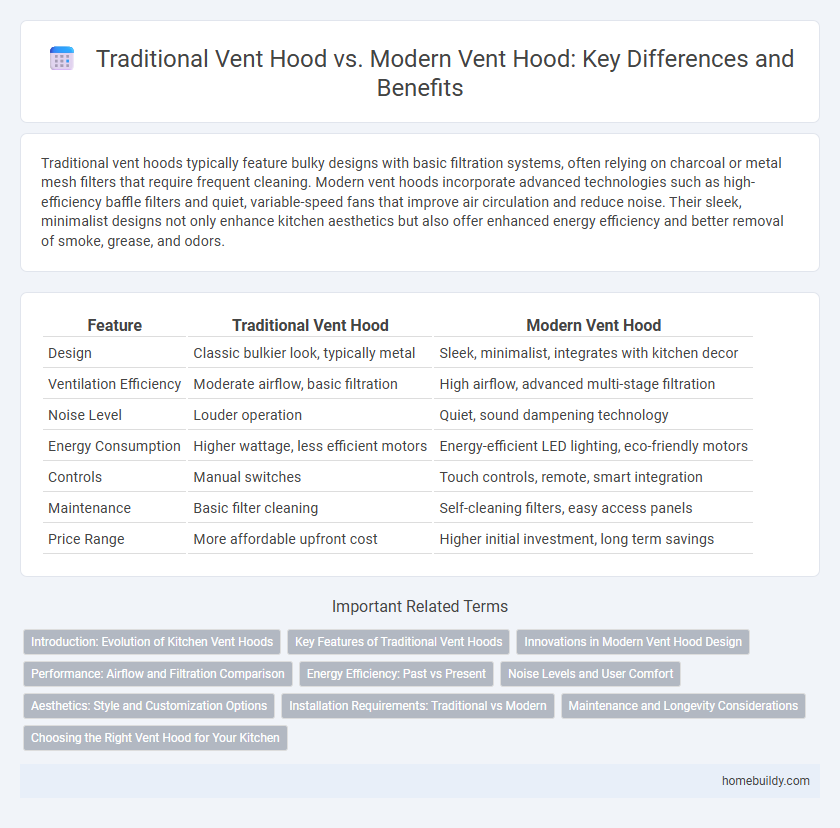Traditional vent hoods typically feature bulky designs with basic filtration systems, often relying on charcoal or metal mesh filters that require frequent cleaning. Modern vent hoods incorporate advanced technologies such as high-efficiency baffle filters and quiet, variable-speed fans that improve air circulation and reduce noise. Their sleek, minimalist designs not only enhance kitchen aesthetics but also offer enhanced energy efficiency and better removal of smoke, grease, and odors.
Table of Comparison
| Feature | Traditional Vent Hood | Modern Vent Hood |
|---|---|---|
| Design | Classic bulkier look, typically metal | Sleek, minimalist, integrates with kitchen decor |
| Ventilation Efficiency | Moderate airflow, basic filtration | High airflow, advanced multi-stage filtration |
| Noise Level | Louder operation | Quiet, sound dampening technology |
| Energy Consumption | Higher wattage, less efficient motors | Energy-efficient LED lighting, eco-friendly motors |
| Controls | Manual switches | Touch controls, remote, smart integration |
| Maintenance | Basic filter cleaning | Self-cleaning filters, easy access panels |
| Price Range | More affordable upfront cost | Higher initial investment, long term savings |
Introduction: Evolution of Kitchen Vent Hoods
Traditional vent hoods relied on basic mechanical ventilation with limited airflow control and often featured bulky, less efficient designs. Modern vent hoods incorporate advanced technologies such as variable-speed fans, improved filtration systems, and sleek, energy-efficient materials that enhance both performance and kitchen aesthetics. This evolution reflects growing consumer demand for quieter operation, better air quality, and seamless integration with contemporary kitchen layouts.
Key Features of Traditional Vent Hoods
Traditional vent hoods typically feature heavy-duty metal construction, often made from stainless steel or copper, ensuring durability and heat resistance. These hoods rely on powerful, high-capacity fans designed to effectively remove smoke, grease, and odors from the kitchen environment. Their classic design often includes decorative elements such as crown molding or embossed patterns, combining functionality with an aesthetic appeal suitable for traditional kitchen styles.
Innovations in Modern Vent Hood Design
Modern vent hoods incorporate advanced filtration technologies such as multi-stage carbon filters and baffle filters that enhance air purification and reduce odors more effectively than traditional mesh filters. Innovative features like smart sensors for automatic airflow adjustment and quieter, energy-efficient brushless motors significantly improve kitchen ventilation performance. Additionally, sleek, minimalist designs with integrated LED lighting and touch controls offer enhanced functionality and aesthetic appeal compared to bulky traditional vent hoods.
Performance: Airflow and Filtration Comparison
Traditional vent hoods typically provide basic airflow rates of 200-400 CFM with standard mesh filters that capture large grease particles but often lack advanced filtration capabilities. Modern vent hoods deliver enhanced performance with airflow ranging from 600-1200 CFM, employing multi-layered baffle or carbon filters that effectively remove fine grease and odors, improving kitchen air quality. Advanced motor technologies and sensor-based controls in modern designs optimize ventilation efficiency while reducing noise levels.
Energy Efficiency: Past vs Present
Traditional vent hoods typically relied on less efficient motors and basic filtration, resulting in higher energy consumption and lower air quality performance. Modern vent hoods incorporate advanced technologies such as variable-speed fans, LED lighting, and improved aerodynamics, significantly reducing electricity use and enhancing ventilation efficiency. Energy Star-rated models exemplify these advancements, offering up to 40% energy savings compared to conventional designs.
Noise Levels and User Comfort
Traditional vent hoods typically produce higher noise levels due to less efficient fan motors and older insulation materials, leading to increased sound disruption in the kitchen. Modern vent hoods incorporate advanced sound-dampening technology and variable-speed fans that significantly reduce noise, enhancing user comfort during cooking. Improved airflow design in contemporary models minimizes vibrations and ensures quieter operation, making them preferable for noise-sensitive environments.
Aesthetics: Style and Customization Options
Traditional vent hoods typically feature classic designs with limited customization, often emphasizing prominent chimney-style structures and basic finishes like stainless steel or white paint. Modern vent hoods offer sleek, minimalist aesthetics and extensive customization options, including integrated lighting, variable materials such as glass, metal, and wood, and smart technology integration for a seamless kitchen look. The contemporary styles prioritize both form and function, enhancing kitchen decor while providing personalized ventilation solutions.
Installation Requirements: Traditional vs Modern
Traditional vent hoods typically require extensive ductwork and professional installation to ensure proper ventilation and compliance with building codes, often involving ceiling or wall-mounted exhaust systems. Modern vent hoods feature more flexible installation options, including ductless or recirculating models with built-in air filters, reducing the need for complex venting infrastructure. These advancements in modern vent hood design allow for easier installation in a variety of kitchen layouts, making them suitable for both new constructions and retrofits.
Maintenance and Longevity Considerations
Traditional vent hoods often require more frequent cleaning and maintenance due to their bulky filters and less efficient grease trapping, which can shorten their lifespan. Modern vent hoods utilize advanced materials and designs like washable filters and improved ventilation systems, reducing maintenance efforts and enhancing durability. Investing in a modern vent hood can lead to longer service life and lower upkeep costs over time.
Choosing the Right Vent Hood for Your Kitchen
Traditional vent hoods often feature bulky designs and basic ventilation capabilities, primarily focused on removing smoke and grease from cooking areas. Modern vent hoods incorporate advanced technologies such as variable speed fans, improved filtration systems, and sleek, space-saving designs that enhance both functionality and kitchen aesthetics. Selecting the right vent hood depends on kitchen size, cooking habits, and ventilation needs, with modern models offering greater efficiency and quieter operation for contemporary homes.
Traditional vent hood vs Modern vent hood Infographic

 homebuildy.com
homebuildy.com